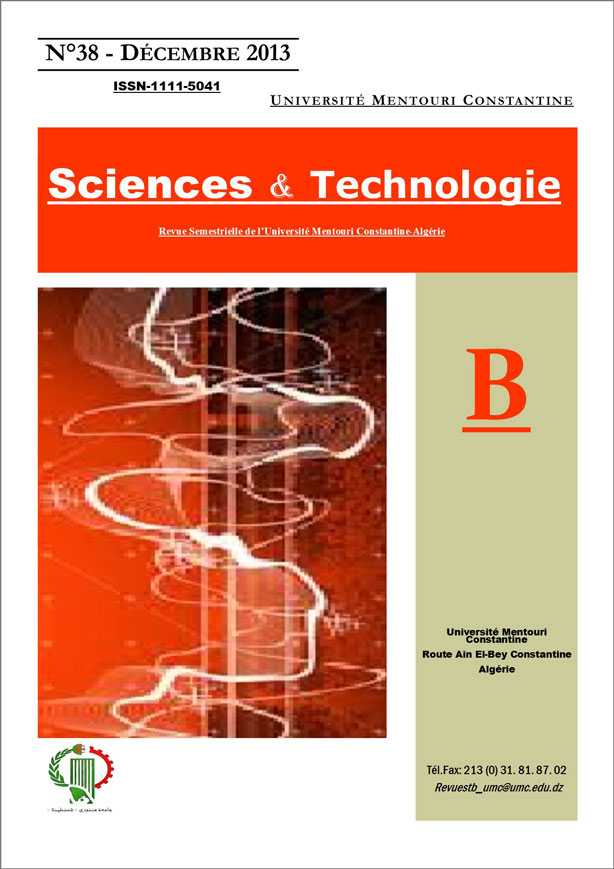REALIZATION AND CALIBRATING OF A DIP COATER FOR THIN FILMS DEPOSITION
الكلمات المفتاحية:
Automatic، Frequency converter، Motion control، Dip coating، ZnO thin filmsالملخص
In this work a homemade dip coater was carried out and calibrated in the laboratory in order to prepare thin films using sol-gel process. This system allows a translation motion downwardly and upward with a controlled speed. The down and up positions are fixed using two proximity sensors.
A sample holder is immersed in a solution for a predetermined time and then is removed. The dipping speed, withdrawing speed and immersion time are controlled easily by the user in a wide range of choices. This dip coater works in automatic mode and it can be used manually. The dipping and withdrawing speeds were identified to frequencies of the converter. The stability of the system was well demonstrated. The XRD characterization of zinc oxide thin films obtained by using this dip coater shows three strong peaks of ZnO respectively (101), (002) and (100). This low cost system has proved its robustness and reliability.
المراجع
T.Ohshima,R.K.Thareja,Y.yamagat, et all., “Laser ablated plasma for deposition of ZnO thin films on various substrates,”Science and technology of advenced materiels., vol. 2, pp. 517–523 ,2001.
Jae Bin Leea, Hyeong Joon Kimb, Soo Gil Kimc, Cheol Seong Hwangb, Seong-Hyeon Hongb, Young Hwa Shinc, Neung Hun Leec., “ Deposition of ZnO thin films by magnetron sputtering for a film bulk acoustic resonator,” Thin Solid Films., vol. 435, pp. 179–185,2003.
Doyoung Kim, Ilgu Yun, Hyungjun Kim., “Fabrication of rough Al doped ZnO films deposited by low pressure chemical vapor deposition for high efficiency thin film solar cells,” Current Applied Physics., vol. 10, pp.459–462, 2010
R. Ayouchia, F. Martinb, D. Leinena, J.R. Ramos-Barradoa., “Growth of pure ZnO thin films prepared by chemical spray pyrolysis on silicon ,”Journal of Crystal Growth., vol 247, pp. 497–504, 2003.
Saliha Ilican , Mujdat Caglar, Yasemin Caglar ., “Sn doping effects on the electro-optical properties of sol gel derived transparent ZnO films,”Applied Surface Science , vol.256; pp 7204–7210,2010.
Chien-Yie Tsay , Hua-Chi Cheng , Yen-Ting Tung, Wei-Hsing Tuan , Chung-Kwei Lin ., “Effect of Sn-doped on microstructural and optical properties of ZnO thin films deposited by sol–gel method,” Thin Solid Films ., vol517., pp. 1032–1036, 2008.
Masashi Shoyama, Noritsugu Hashimoto., “ Effect of poly ethylene glycol addition on the microstructure and sensor characteristics of SnO2 thin films prepared by sol–gel method,”Sensors and Actuators B., vol. 93,pp. 585–589, 2003.
Jinming Liu, Xiaoru Zhao, Libing Duan, Mengmeng Cao, Huinan Sun, Jifeng Shao, Shuai Chen, Haiyan Xie, Xiao Chang, Changle Chen., “Influence of annealing process on conductive properties of Nb-doped TiO2 polycrystalline films prepared by sol–gel method,” Applied Surface Science, vol.257, pp.10156– 10160, 2011.
N. V. Kaneva, C. D. Dushkin ., “Preparation of nanocrystalline thin films of ZnO by sol-gel dip coating,” Bulgarian Chemical Communications, vol. 43, pp. 259–263, 2011.
Joseph W. Krozel, Ahmet N. Palazoglu, Robert L. Powell ., “Experimental observation of dip-coating phenomena and the prospect of using motion control to minimize fuid retention ,” Chemical Engineering Science., vol. 55, pp.3639–3650, 2000.
V. Musat a, A.M. Rego , R. Monteiro , E. Fortunato., “ Microstructure and gas-sensing properties of sol–gel ZnO thin films,”Thin Solid Films., vol.516, pp.1512–1515, 2008.
التنزيلات
منشور
كيفية الاقتباس
إصدار
القسم
الرخصة
Les auteurs publiant dans cette revue acceptent les termes suivants :- Les auteurs détiennent le droit d'auteurs et accordent à la revue
le droit de première publication, avec l’ouvrage disponible simultanément [SPÉCIFIER LA PÉRIODE DE TEMPS] après publication, sous la licence Licence d’attribution Creative Commons qui permet à d'autres de partager l'ouvrage en en reconnaissant la paternité et la publication initiale dans cette revue. - Les auteurs peuvent conclure des ententes contractuelles additionnelles et séparées pour la diffusion non exclusive de la version imprimée de l'ouvrage par la revue (par ex., le dépôt institutionnel ou la publication dans un livre), accompagné d'une mention reconnaissant sa publication initiale dans cette revue.
- Les auteurs ont le droit et sont encouragés à publier leur ouvrage en ligne (par ex., dans un dépôt institutionnel ou sur le site Web d'une institution) avant et pendant le processus de soumission, car cela peut mener à des échanges fructueux ainsi qu'à un nombre plus important, plus rapidement, de références à l’ouvrage publié (Consulter The Effect of Open Access).

